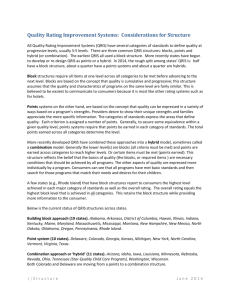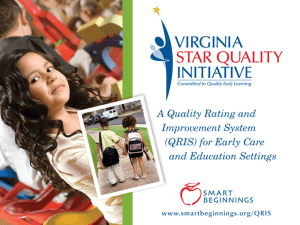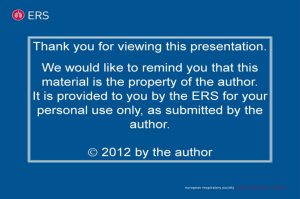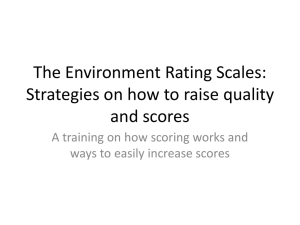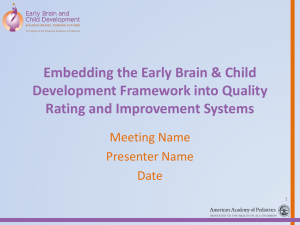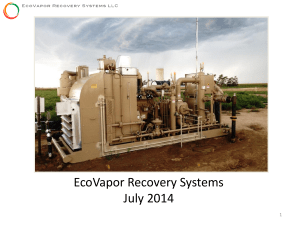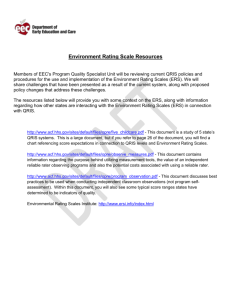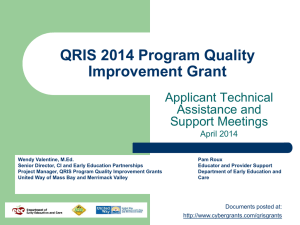Quality Improvement in Minnesota`s QRIS
advertisement
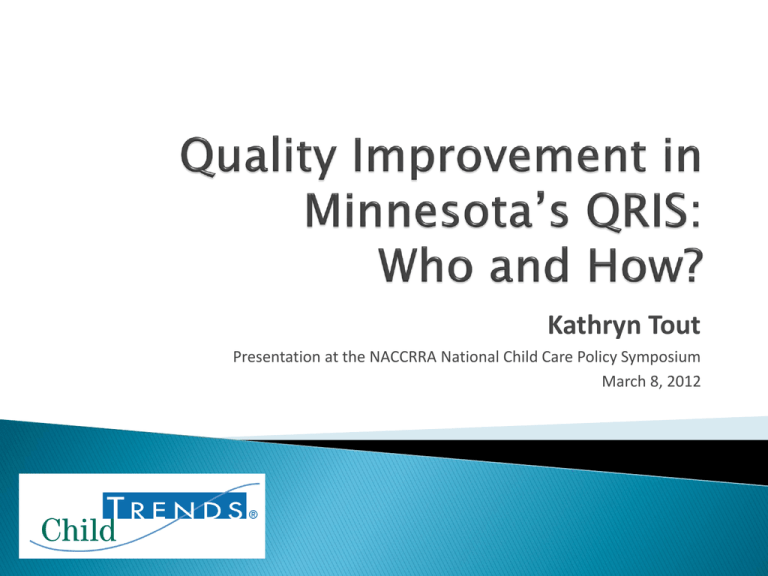
Kathryn Tout Presentation at the NACCRRA National Child Care Policy Symposium March 8, 2012 Parent Aware Evaluation Team ◦ ◦ ◦ ◦ ◦ ◦ Rebecca Starr Tabitha Isner Jennifer Cleveland Meg Soli Katie Quinn Ladia Albertson-Junkans Minnesota Early Learning Foundation Greater Twin Cities United Way Office of Planning, Research and Evaluation in the Administration for Children and Families, U.S. Department of Health and Human Services ◦ INQUIRE – Quality Initiatives Research and Evaluation Consortium QRIS Compendium – information from 26 QRIS collected in late 2009 from QRIS administrators and publicly available documents The majority of QRIS provide TRAINING that is aligned with QRIS standards and ON-SITE TECHNICAL ASSISTANCE to support programs These supports tend to focus primarily on “navigating” the QRIS and improving environment ratings Training and TA address interactions with children to a lesser extent (see new report by NCCP) Majority of QRIS in the Compendium reported that the frequency, length, and duration of onsite assistance varied by the needs of the program Work usually is guided by a QI plan. Intensity and content of TA will vary also on the stage of the rating cycle (pre-entry or preparation phase; entry to the QRIS; re-rating and improvement phase) (see Isner et al, 2011) Review findings on quality improvement from one QRIS – Minnesota’s Parent Aware – to examine how well QI strategies are working Analyze who improves and how they improve Discuss implications of the findings for improving QI in QRIS Voluntary QRIS Two rating pathways ◦ Full rating: 1 to 4 stars ◦ Accelerated 4-star rating for accredited programs, Head Start and school-based pre-kindergarten programs Points are earned in four quality dimensions ◦ ◦ ◦ ◦ Family Partnerships Teaching Materials and Strategies Tracking Learning Teacher Training and Qualifications Provider Resource Specialist – facilitates and oversees the process for programs ERS Consultant CLASS Coach Financial assistance for QI expenditures Re-Ratings in Parent Aware 1 star, 0% 4 stars, 10% 1 star, 14% 3 stars, 34% Initial Rating 2 stars, 15% 4 stars, 43% 2 stars, 42% 3 stars, 42% Second Rating N=97 Improvements by at least one star level at second rating: ◦ 60% of centers ◦ 70% of family child care providers One-third of family child care providers increased by at least two star levels 11% of centers decreased their rating by one star compared to 2% of centers Average change in points at re-rating 8 6 4 2 0 -2 Decreased by one Stayed the same or more stars (N=5) star rating (N=28) -4 Improved by one Improved by more star (N=38) than one star (N=26) Family Partnerships Teaching Materials and Strategies Tracking Learning Teacher Training and Education Points are earned in the Teaching Materials and Strategies category for ERS and CLASS scores Programs gain about 1/3rd of a point on ERS scores. Programs gain about 1/3rd of a point on Classroom Organization and nearly half a point on Emotional Support. However, no gains are made on measures of Instructional Support. Quality improvement supports in Parent Aware Seven PRSs reported on services to 83 programs (34 centers, 49 family child care) Hours of direct contact ◦ Range: 3 to 30 hours ◦ Average: 8.2 hours Average number of site visits per program – 3.6 PRSs spend twice as many hours of direct contact with providers who are English Language Learners than English-speaking providers ◦ 12.7 hours compared to 6.2 hours PRSs spend more time with family child care providers than center-based programs ◦ 9.9 hours compared to 6.3 hours PRSs report that their most common activities with programs are: ◦ Assembling the QRIS documentation packet ◦ Preparing programs for their ERS observations ◦ Picking out new materials or equipment for the program Percent of Rating Cycles Family child care 100 90 80 70 60 50 40 30 20 10 0 Center-based Level of Need Average Contact Hours Average Number of Site Visits % that are “very engaged and open to support” Average Star Rating Few needs 5.6 hours 2.7 visits 57% 3.5 Average needs 8.8 hours 3.7 visits 90% 2.9 More needs 11.2 hours 4.8 visits 85% 2.5 Five ERS consultants reported on services to 77 programs (29 centers, 48 family child care) Hours of consultation ◦ Range: 2 to 40 hours ◦ Average: 13.75 hours Average number of site visits per program – 6.4 ERS consultants spend more hours of consultation with family child care providers than with center-based programs ◦ 15 hours compared to 12 hours In centers, ERS consultants worked with 1, 2, or 3 classrooms Hours of consultation differed for family child care providers who received different star levels ◦ 2- or 3- stars – 16.9 hours ◦ 4 stars – 10.6 hours No difference in hours of consultation for centers that received different star levels Most common activities that providers report doing with their ERS consultant ◦ ◦ ◦ ◦ Understanding the ERS scoring system Rearranging the physical space Purchasing new materials Learning hand washing and other sanitation procedures ERS Consultants reported that programs were “very engaged and open to consultation” in 79% of the rating cycles Family child care providers were slightly more engaged (85%) compared to center-based providers (68%) Hours spent with “very engaged” programs – 15.6 hours Hours spent with “not engaged” programs – 9.5 hours No correlation between hours of consultation and ERS score for centers Hours of consultation was negatively correlated with FCCERS-R scores for family child care providers Two CLASS coaches reported on services to 13 centerbased programs Hours of coaching ◦ Range: 4 to 67 hours ◦ Average: 23.2 hours Average number of site visits per program – 8.8 CLASS coaches worked with 1 or 2 classrooms per center Providers reported on the activities they did with their CLASS Coach The most common activities were: ◦ Observing me teach and giving me feedback – 76% ◦ Helping me organize my classroom processes to aid children’s learning – 59% ◦ Helping me understand the CLASS scales – 41% ◦ Helping me understand the CLASS scoring – 35% CLASS Coaches report than only 38% of providers are “very engaged”; 23% were “somewhat disengaged or hesitant” The average total expenditure per rating through June, 2011 was $2,791 Average expenditure was significantly greater for family child care programs ($2,923) compared to centers ($2,604) Expenditures per rating were classified into categories. ◦ The largest portion of the expenditure was made on materials for the learning environment – books, toys, games (59%) ◦ The second largest portion was on equipment for the learning environment – shelves, playground equipment (33%) ◦ Training and consultation, teacher resource materials and assessment materials made up the remaining 8% of expenditures Free training – 65% Free curriculum materials -65% Free assessment materials – 61% Financial assistance – 61% Provider Resource Specialist – 53% ERS Consultant – 34% Feedback reports from ERS – 36% Publicity materials – 24% Programs make significant improvements in their star level when they are re-rated Programs make small but significant improvements on ECERS-R, ITERS-R and FCCERS-R Programs make small improvements on the CLASS but not on the Instructional Support scale Providers who are English Language Learners and family child care providers receive more hours of support from PRSs and ERS consultants PRSs and ERS Consultants spend the majority of their time with providers on activities that do not involve interactions with children – paperwork, learning about the ERS, buying supplies and materials Developing models to work with providers who are not engaged – what works best? Continuing to develop supports for high priority providers such as English Language Learners and family child care providers Focusing site visits and consultation on activities that relate more directly to interactions with children ◦ May require a change in the Quality Standards Ensuring that financial supports are adequate to make “real” changes Please contact Kathryn Tout ktout@childtrends.org
